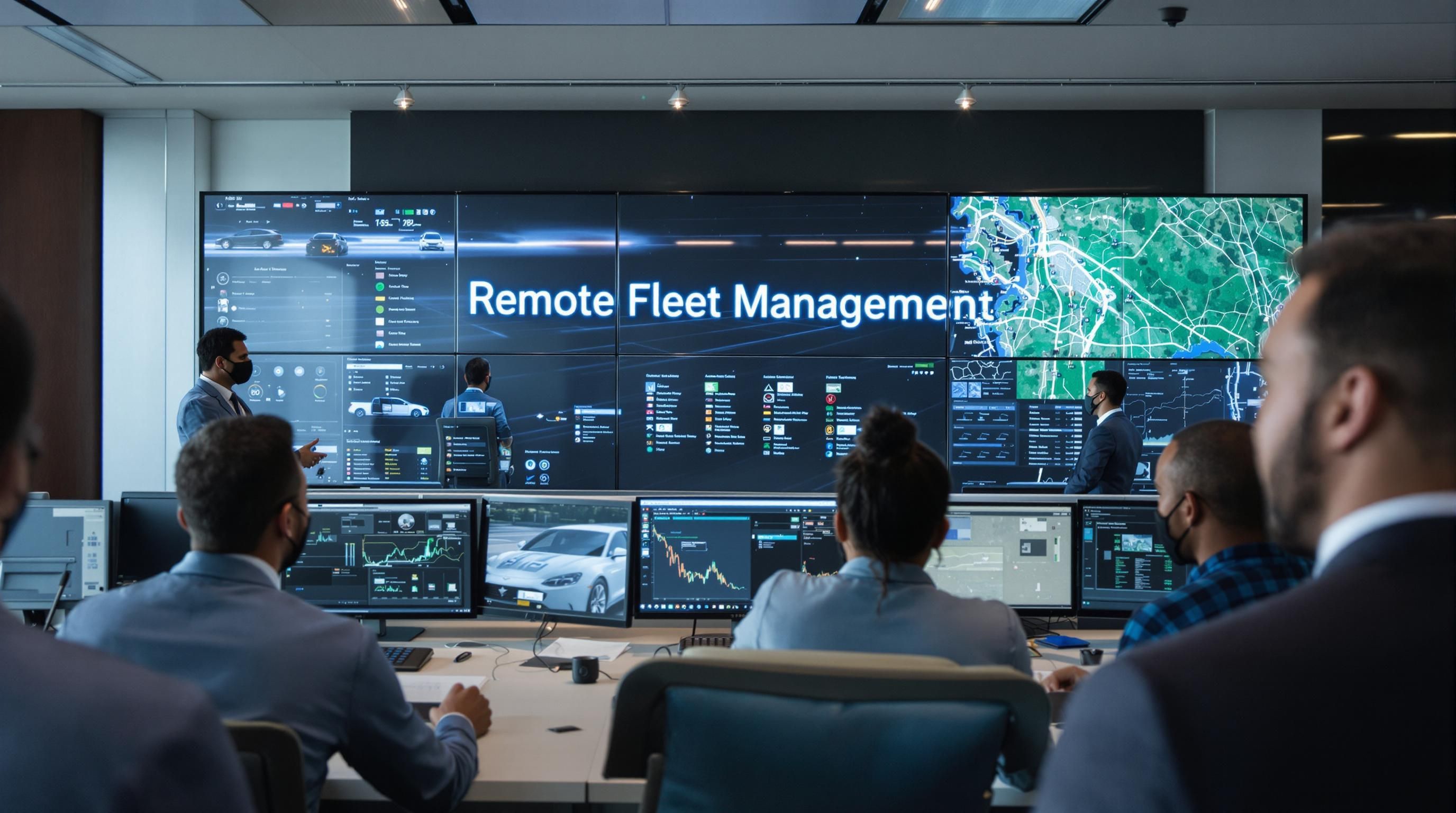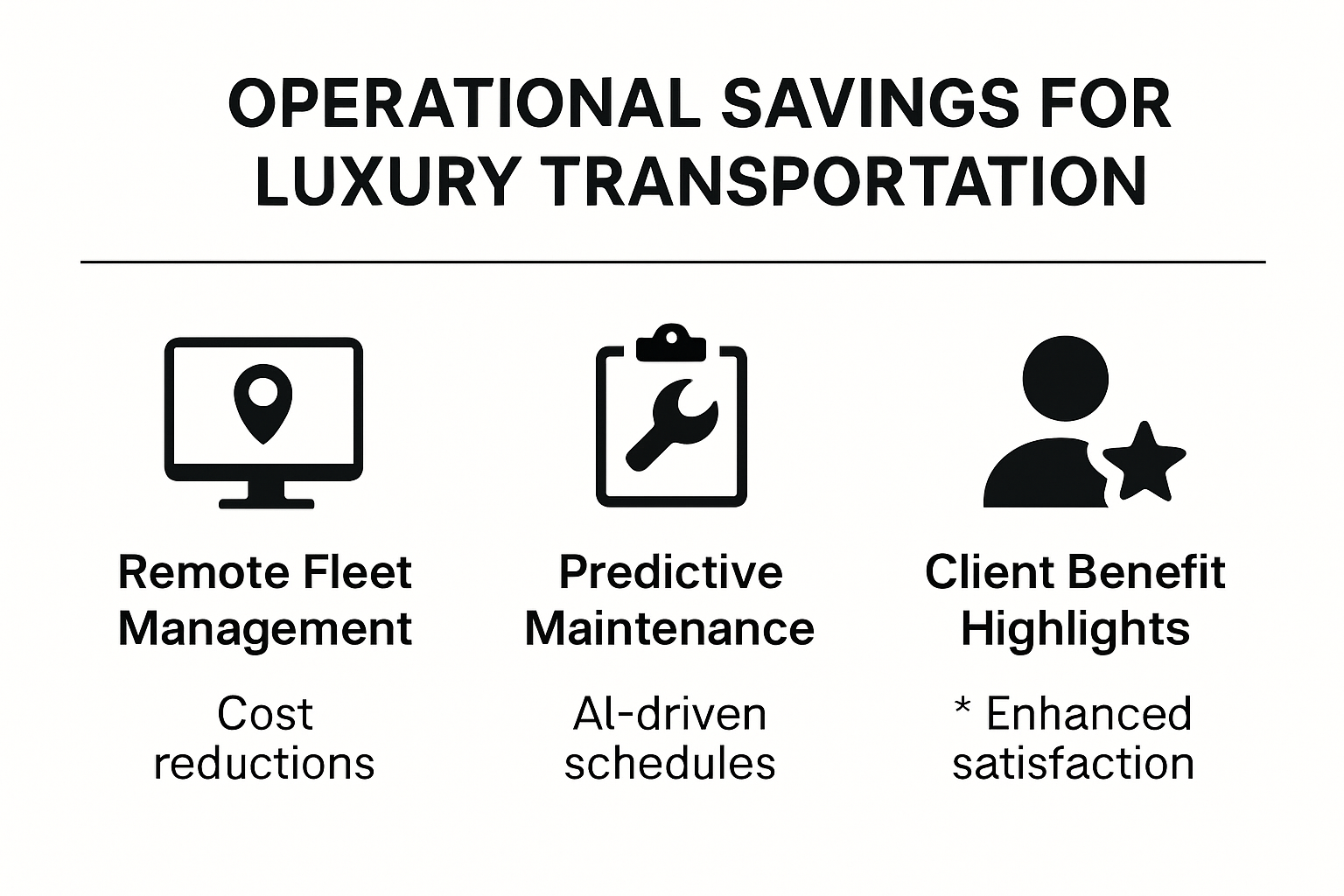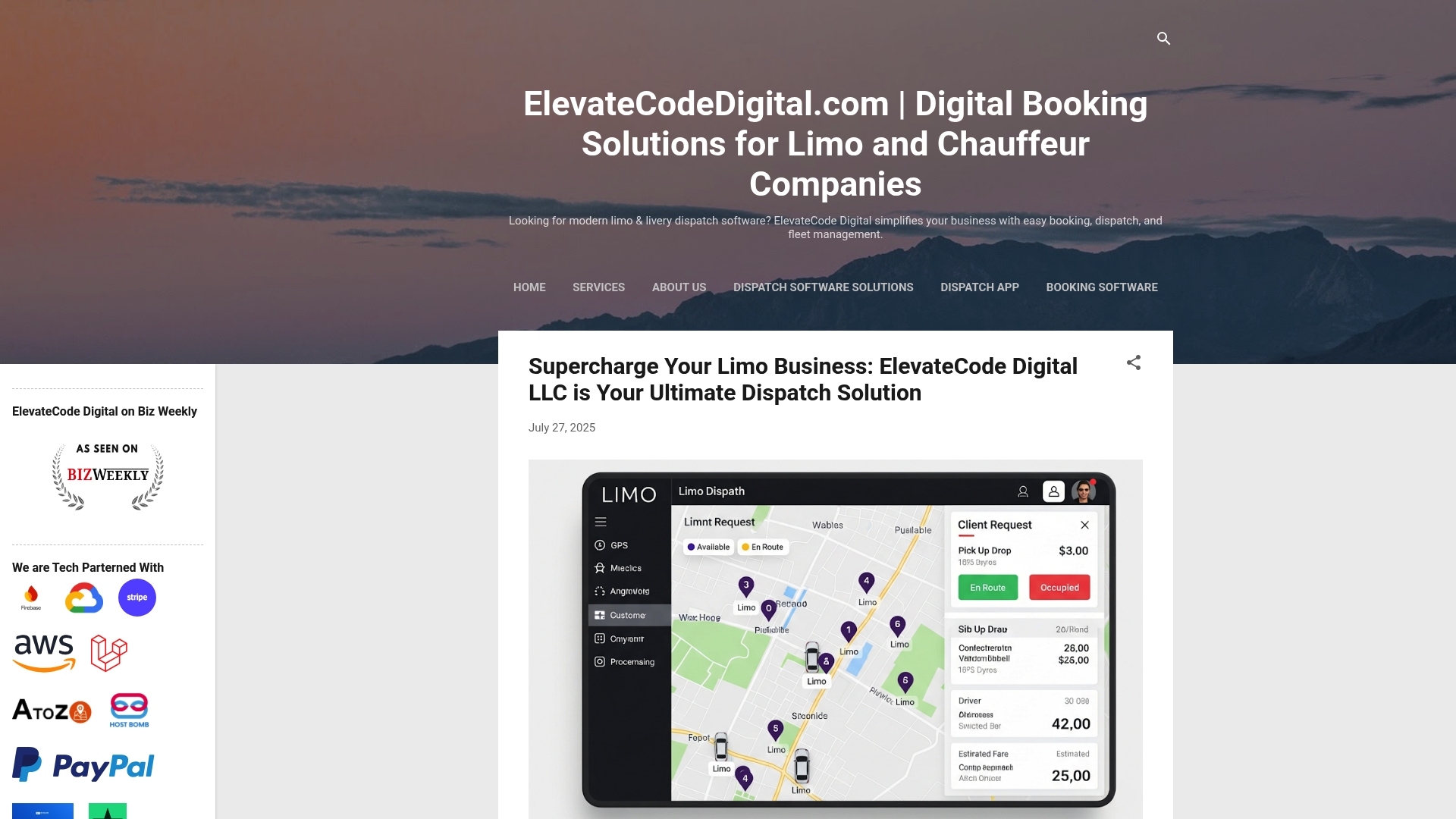Remote Limo Fleet Management for Luxury Transportation 2025

Luxury transportation is rapidly shifting into a new era built on digital control and smart data. Nearly every high-end operator is exploring ways to remotely track cars, monitor drivers, and reduce costly downtime. Yet the biggest reveal is not just tech for tech’s sake. Companies using remote fleet management can cut their operating costs by up to 20 percent. This is not just about using new gadgets. It’s about unlocking profit and delivering an experience that sets you apart in 2025.
Table of Contents
- What Is Remote Fleet Management?
- Key Benefits for Limousine and Luxury Operators
- Top Features to Look for in 2025
- Implementation Steps and Success Tips
Quick Summary
| Takeaway | Explanation |
|---|---|
| Adopt Remote Fleet Management for Efficiency | Implementing remote fleet management can reduce operational costs by up to 20% through careful tracking and optimization. |
| Utilize AI for Predictive Maintenance | Advanced systems use AI to predict maintenance needs, preventing vehicle breakdowns and reducing unexpected repairs. |
| Enhance Client Experience with Real-Time Updates | Provide clients with accurate location updates and arrival estimates, improving service reliability and client trust. |
| Conduct Thorough Organizational Assessments | Perform a comprehensive analysis of current operations before implementation to identify gaps and set clear goals. |
| Invest in Staff Training alongside Technology | Successful deployment relies on training staff collaboratively, ensuring they are well-equipped to use new technologies effectively. |
What Is Remote Fleet Management?
Remote fleet management represents a sophisticated technological approach to monitoring, controlling, and optimizing commercial vehicle operations without physical presence. By leveraging advanced digital technologies, transportation businesses can now track, analyze, and manage entire vehicle fleets from centralized command centers or even mobile devices.
The Core Technology Behind Remote Management
At its foundation, remote fleet management relies on integrated telematics systems that combine telecommunications and informatics. Learn more about digital fleet optimization to understand how these technologies work together. According to Wikipedia's telematics overview, these systems utilize GPS tracking, onboard diagnostics, and wireless communication networks to provide real-time insights into vehicle performance, location, and operational efficiency.
The technology enables transportation managers to collect comprehensive data including vehicle speed, fuel consumption, route optimization, driver behavior, and maintenance requirements. By transforming raw operational data into actionable intelligence, businesses can make strategic decisions that reduce operational costs and enhance overall fleet performance.
Key Components of Remote Fleet Management
Remote fleet management encompasses several critical components that work synergistically to deliver comprehensive operational control. These include:
- GPS Tracking: Provides precise vehicle location and movement tracking
- Vehicle Diagnostics: Monitors mechanical health and predicts potential maintenance needs
- Driver Performance Analytics: Evaluates driver behavior, safety, and efficiency
- Route Optimization: Calculates most efficient paths to reduce fuel consumption and travel time
The National Institutes of Health demonstrates how strategic implementation of remote fleet management can significantly reduce operational expenses. By collecting detailed operational data, organizations can make informed decisions about vehicle acquisition, maintenance scheduling, and overall fleet strategy.
For luxury transportation providers, remote fleet management is not just a technological enhancement but a competitive necessity. It allows businesses to maintain high service standards, ensure passenger safety, and optimize operational efficiency in an increasingly digital and data-driven transportation ecosystem. The ability to monitor multiple vehicles simultaneously, predict maintenance needs, and respond quickly to operational challenges sets forward-thinking transportation companies apart in a competitive market.
Here’s a table summarizing the core components of remote fleet management and their primary functions:
| Component | Primary Function |
|---|---|
| GPS Tracking | Tracks vehicle location and movement in real-time |
| Vehicle Diagnostics | Monitors mechanical health and predicts maintenance needs |
| Driver Performance Analytics | Evaluates driver behavior, safety, and efficiency |
| Route Optimization | Calculates most efficient routes to minimize fuel and time |
Key Benefits for Limousine and Luxury Operators
Remote fleet management offers transformative advantages for luxury transportation operators, providing unprecedented control and efficiency in an increasingly competitive market. Learn more about strategic business growth for understanding these technological advancements.
Enhanced Operational Precision and Cost Management
Luxury transportation businesses can dramatically improve operational efficiency through remote fleet management technologies. According to McKinsey & Company, companies implementing advanced telematics can reduce operational costs by up to 20% through precise tracking and optimization. This includes minimizing fuel consumption, reducing unnecessary vehicle idle time, and implementing more strategic maintenance schedules.
The ability to monitor vehicle performance in real-time allows operators to make data-driven decisions. Predictive maintenance alerts help prevent unexpected breakdowns, ensuring luxury vehicles remain in pristine condition and maintain the high standards clients expect. By identifying potential mechanical issues before they escalate, operators can significantly reduce unexpected repair costs and vehicle downtime.

Advanced Client Experience and Safety Management
Remote fleet management transforms client experience in luxury transportation through unprecedented transparency and reliability. Key benefits include:
- Real-Time Tracking: Provide clients with precise location updates and accurate arrival estimates
- Driver Performance Monitoring: Ensure consistently high-quality service and professional driving standards
- Route Optimization: Minimize travel time and maximize client comfort
The National Transportation Safety Board emphasizes that advanced telematics directly contribute to improved driver safety and reduced accident rates. For luxury transportation providers, this translates to enhanced reputation and client trust.
Beyond immediate operational benefits, remote fleet management positions luxury transportation businesses at the forefront of technological innovation. The ability to adapt quickly, leverage data-driven insights, and provide superior service sets forward-thinking operators apart in a competitive market. As client expectations continue to evolve, those who embrace these technological solutions will define the future of luxury transportation.
Here's a table outlining the key benefits remote fleet management delivers to luxury transportation operators:
| Benefit | Description |
|---|---|
| Cost Reduction | Cuts operational costs by up to 20% |
| Predictive Maintenance | Prevents breakdowns and minimizes repair costs |
| Enhanced Service Quality | Ensures consistent high-quality and reliable client experience |
| Real-Time Updates | Provides clients with accurate tracking and arrival estimates |
| Improved Driver Safety | Monitors and optimizes driver behavior, reducing accident risks |
Top Features to Look for in 2025
As luxury transportation operators prepare for technological advancements in 2025, selecting the right remote fleet management features becomes critical for maintaining competitive edge. Explore advanced fleet management solutions to understand the evolving technological landscape.
Artificial Intelligence and Predictive Analytics
According to research from ArXiv, advanced predictive analytics are transforming fleet management strategies. The most sophisticated remote fleet management systems now incorporate AI-driven algorithms that go beyond traditional tracking. These intelligent systems analyze historical data, current operational conditions, and potential future scenarios to provide actionable insights.
Key AI capabilities include predictive maintenance scheduling, which anticipates vehicle repair needs before mechanical failures occur, and dynamic route optimization that considers real-time traffic patterns, weather conditions, and vehicle performance metrics. By leveraging machine learning, luxury transportation operators can reduce unexpected downtime, optimize fuel consumption, and enhance overall fleet efficiency.
Comprehensive Integration and Connectivity
Modern remote fleet management solutions must offer seamless integration across multiple technological platforms. The most advanced systems provide:
- Multi-Platform Compatibility: Synchronization across mobile, desktop, and tablet interfaces
- API Integration: Smooth connection with existing booking and dispatch systems
- Cloud-Based Infrastructure: Secure, scalable data management and real-time access
The Wikipedia overview of fleet management emphasizes the importance of comprehensive technological ecosystems. Luxury transportation providers need solutions that not only track vehicles but also integrate with customer relationship management systems, financial reporting tools, and driver performance monitoring platforms.
As we approach 2025, the most effective remote fleet management features will transcend traditional tracking capabilities. They will function as comprehensive business intelligence platforms, providing operators with unprecedented visibility into every aspect of their transportation ecosystem. The ability to collect, analyze, and act on complex operational data will distinguish market leaders from their competitors. Luxury transportation businesses that invest in advanced, AI-powered, and fully integrated remote fleet management technologies will be best positioned to deliver exceptional service, optimize operational efficiency, and drive sustainable growth in an increasingly digital marketplace.
Implementation Steps and Success Tips
Successful remote fleet management implementation requires strategic planning, technological investment, and organizational commitment. Discover comprehensive fleet transformation strategies to guide your technological transition.
Strategic Planning and Assessment
Before implementing remote fleet management technologies, luxury transportation operators must conduct a comprehensive organizational assessment. According to the Federal Energy Management Program, successful implementation begins with thoroughly evaluating current fleet operations, identifying performance gaps, and establishing clear technological migration objectives.
This assessment should include detailed analysis of existing vehicle utilization, maintenance protocols, operational inefficiencies, and technological infrastructure. Transportation businesses must develop a phased implementation strategy that allows gradual technological integration, minimizing operational disruptions. Key considerations include compatibility with existing systems, staff training requirements, and potential return on technological investment.
Technology Integration and Staff Training
Effective remote fleet management implementation hinges on two critical components: advanced technological solutions and comprehensive staff training. The most successful organizations approach this transition as a holistic transformation, not merely a technological upgrade. Essential steps include:
- Gradual System Rollout: Implement technologies in stages to manage complexity
- Comprehensive Staff Training: Develop multi-level educational programs for different organizational roles
- Continuous Performance Monitoring: Establish metrics to track technological effectiveness
The Washington State Department of Enterprise Services emphasizes the importance of creating a robust fleet management framework that balances technological capabilities with human expertise. This means investing not just in software and hardware, but in developing a technology-savvy organizational culture.
Implementing remote fleet management represents more than a technological upgrade it is a strategic organizational transformation. Luxury transportation providers must view this process as an opportunity to redesign operational workflows, enhance service quality, and position themselves at the forefront of industry innovation. Success requires a balanced approach that combines cutting-edge technology with human insight, adaptability, and a commitment to continuous learning and improvement. By embracing this comprehensive perspective, transportation businesses can transform technological challenges into competitive advantages, delivering exceptional value to clients and stakeholders alike.

Frequently Asked Questions
What is remote fleet management in luxury transportation?
Remote fleet management is a technological approach that enables luxury transportation providers to monitor, control, and optimize their vehicle operations from a distance, using digital technologies such as GPS tracking, telematics, and real-time analytics.
How can remote fleet management reduce operational costs?
By implementing remote fleet management solutions, luxury transportation companies can reduce operating costs by up to 20% through improved tracking, optimized fuel consumption, predictive maintenance, and by minimizing unnecessary downtime.
What are the key benefits of using remote fleet management for luxury operators?
The main benefits include enhanced operational efficiency, improved client experience with real-time updates, cost reduction, predictive maintenance to prevent vehicle breakdowns, and improved driver safety through performance monitoring.
What features should luxury transportation operators look for in remote fleet management systems in 2025?
Operators should look for features like artificial intelligence for predictive analytics, comprehensive integration capabilities with existing systems, multi-platform compatibility, and cloud-based data management to ensure real-time access and scalability.
Ready to Revolutionize Your Fleet Management Experience?
Struggling with rising costs, unpredictable vehicle downtime, and pressure to deliver flawless service is common in luxury transportation today. As highlighted in our article, operators everywhere are searching for ways to harness remote fleet management for faster bookings, smarter dispatch, and real-time control. Your goal is clear: combine digital precision with a client experience that no competitor can match.

The tools to achieve this are available now. ElevateCodeDigital.com empowers limo and chauffeur businesses with advanced booking and dispatch platforms built for automation. Find web and mobile apps, AI-powered fleet analytics, and seamless driver monitoring that fit your unique needs. Do not settle for outdated processes when you can transform your service quality and profitability immediately. Explore how our tailored software solutions can bring your remote fleet management vision to life. Book your personalized demo today and take the next step toward a more efficient and profitable operation.
Recommended
- How to Reduce Fleet Costs in 2025 for Luxury Limo and Transport Operators
- What Is Dispatch Software? The 2025 Guide for Luxury Fleets
- Revolutionize Your Limo & Chauffeur Business with Our White-Label Dispatch Software
- Automated Booking Systems for Limo and Fleet Services 2025

Comments
Post a Comment